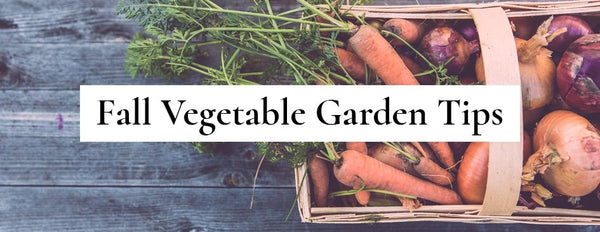Fall Vegetable Garden Tips
Oct 27, 2017
Summer’s gone and there’s a change in the air that hints at the approaching first frost. Fall doesn’t mean you need to pack in your vegetable plot just yet—with these fall vegetable garden tips, you can enjoy garden-fresh produce all the way up to (and sometimes beyond) the first frost.
Timing Your Fall Harvest
In the spring, you plan your planting around the date of the last frost of the spring. In the fall, you reverse the process. Find your local area’s average first fall frost date, and look at the number of days needed to harvest your fall vegetables. Use the harvest time and count backwards from the frost date, adding an extra couple of weeks to account for the fact most fall vegetables’ growth slows as the days get shorter.
Fall Cleanup
If you have any debris or old plants left from the summer crop, now’s the time to dig them up. Your soil’s also been put through a workout over the summer, so consider adding some compost before planting your fall vegetables. Speaking of which . . . .
The Best Veggies to Plant in Fall
We’d be lax if our fall vegetable garden tips didn’t include a list of cool weather veggies to plant. While sun-kissed tomatoes and plump red peppers aren’t an option, you can plant a wide variety of vegetables in the fall. Look for vegetables that grow well in cooler temperatures and only take about forty days from sowing to harvest.
If you start them before planting, you can transplant broccoli, cabbage, cauliflower, and kale in the fall. Swiss chard, lettuce, peas, spinach, and broccoli rabe can be sown as seed. So can beets and carrots, although you may have to harvest them while they’re at the baby vegetable stage.

Frost Protections
With protection, some crops can survive the first frost, and even continue growing into the winter in regions where the temperature doesn’t fall below 20 Fahrenheit. Such vegetables can include:
- Beets
- Broccoli
- Brussel sprouts
- Cabbage
- Carrots
- Collards
- Kale
- Kohlrabi
- Leeks
- Lettuce
- Mustard
- Rutabagas
- Swiss chard
- Turnips.
To protect such crops, cover them with blankets, plastic tunnels, or cardboard boxes in advance of the frost.
Water Needs
Fall vegetables, like summer crops, require about an inch of water a week. Once your seedlings are established (or transplanted), it’s better to give them a deep watering once a week than multiple shallower waterings. This allows the water to seep deeper into the ground, where it’s less likely to freeze in an unexpected frost.

Cover Crops
Perhaps you’re done with gardening now summer’s over, and really don’t need our fall vegetable garden tips. If so, you can start preparing your garden for the winter. One of the best ways to do this is to plant cover crops, or as some gardeners call them, green manure.
A cover crop is a fast-growing plant such as clover, hairy vetch, sorghum, or buckwheat which is allowed to grow and cover your plant beds. The cover crop helps prevent erosion over the winter while adding nutrients to the soil. In the spring, the crop reduces weed growth, and acts as a quick compost when you dig it into the soil. Most cover crops can cover your garden in less than thirty days.
If cover crops sound like too much work, shovel a layer of compost over your garden at the end of the season. As winter temperatures thaw and freeze the ground, the compost is worked into the soil.
Fall Garden Bragging Rights
Growing a bountiful fall garden is a triumph that should be shared. Don’t forget to take pictures of your fall crop and back it up with Picture Keeper Connect. Pictures of your garden help you remember which plants thrived and which you need to focus on more next year.



